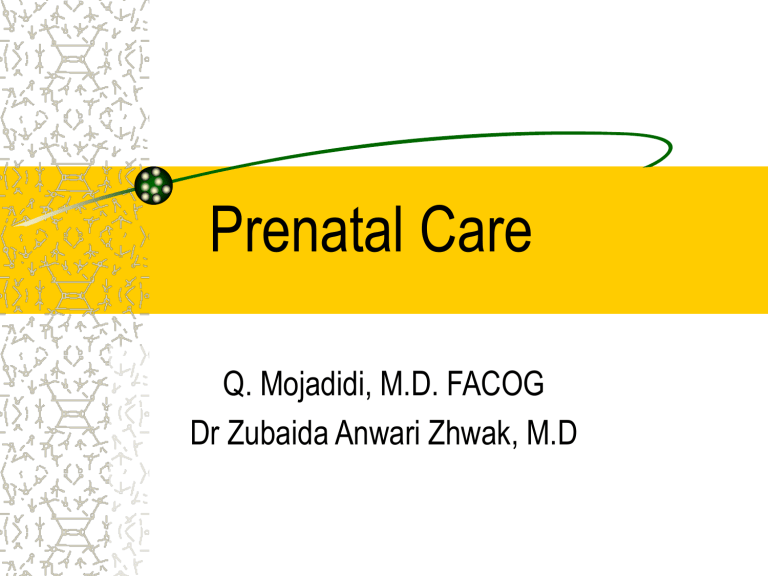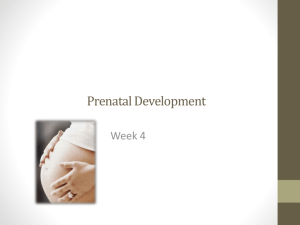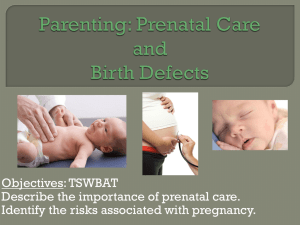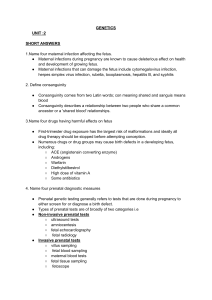
Prenatal Care Q. Mojadidi, M.D. FACOG Dr Zubaida Anwari Zhwak, M.D Objective The objective of prenatal care is to assure that every wanted pregnancy culminates in the delivery of a healthy baby without impairing the health of the mother Objective It is essential for the physician or midwife who assumes responsibility for prenatal care to be familiar with the normal physiological changes, as well as the pathological changes, that may develop during pregnancy “Bad prenatal care may be worse then none” Initial Comprehensive Care Goal: Establish care as early as possible(No later then two missed period) Define the health status of the mother and fetus To determine the gestational age of the fetus • • • • • Last menstrual period (Nagle’s role) Pelvic examination Abdominal size of the uterus Ultrasound X-ray To initiate a plan for continuing obstetrical care To plan for subsequent visits and possible hospitalization Management Complete history and physical examination – – – – Obstetric history and previous complication Family history Habits (nicotine, alcohol, heroin, and craves) Diet, 2500 calories • Recommend high protein, low carbohydrate, 2000mg Na, and persistent hydration – Occupation and daily activity – Is this pregnancy planed – Counsel for breast feeding Obstetrical Examination Visualize the cervix Obtain cytology specimen Take culture swabs for Gonococcus and Chlomydia Evaluate vagina for any infection Bimanual examination to determine the size, position, and consistency of the uterus Clinical pelvimetry Evaluate the adnexa Further Instruction She is tactfully instructed about the following dangerous signs, which must report immediately, day or night 1. 2. 3. 4. 5. 6. 7. 8. 9. 10. Any vaginal bleeding Swelling of the face and or fingers Blurring of the vision Sever or continuous headache Abdominal pain Persistent vomiting Chills or fever Dysuria Escape of fluid from vagina Marked change in frequency or intensity of fetal movement Recommended Interval For Indicated Test And Procedures Time (weeks) Initial as soon as possible 8-18 Assessment H&H, U/A, including microscopic exam. Infection screening (GC, CT, Syphilis, Hepatitis, HIV) blood group and Rh type and antibody screening, Rubella titer, cervical cytology, Ultrasound, amniocentesis, CVS, 16-18 Maternal serum alphafetoprotein, HCG, SE3, Inhibit-A (Quad Screen) (26-28 Repeat antibody test for unsensitized Rh negative patients 32-36 Ultrasound, testing for sexually transmitted diseases, culture for Group B Streptococcus Repeat H&H High Risk Pregnancy Determine on the base of following risk factors the degree of the risk for pregnancy – Previous pregnancy and delivery complication • Operative vaginal delivery, C/Section, VBAC, IUGR, malformation, bleeding – History of preterm birth – Hypertension • Preeclampsia, Eclampsia, Chronic Hypertension, HELLP – Diabetes and or the history of diabetes – Systemic diseases – Socioeconomic status – Abnormal reproductive history • First and second trimester loses • Infertility – Habits, and daily activity – Body Mass Index (BMI) – Nutrition Daily Management Balance diet, 2500 calories – High protein, low carbohydrate, 2000mg Na, and drinking 1012 glasses of water Exercise (routine fitness exercise can continue, no jumping up and down) Daily activity and work may continue Prenatal Vitamins Calcium Folic acid Daily Management Continue Travel, no restriction Bathing and clothing Bowel habit Coitus Douches Care of breast and abdomen Care of the teeth Immunization Smoking Caffeine Medication Subsequent Visits Every four weeks to 28 weeks Every two weeks to 36 weeks Every week to delivery Uterine fundal height measurement, FH, weight, BP, urine dip stick every visit 26-29 weeks one hour GTT, if positive 3hGTT Combs test 28 weeks for Rh negative patients and administer Rho-Gam if negative 36 weeks culture for Group B Streptococcus if available, H&H, RPR Treat high risk patient for GBS during labor – Prolong PRM more then 18 h, P-PROM, maternal fever, preterm labor, history of previous GBS newborn, UTI caused by GBS Prenatal Surveillance Fetal – – – – – Fetal heart rate Size of fetus(es), actual and rate of change Amount of amniotic fluid Presenting part and station (late in pregnancy) Fetal activity (fetal kick count) Prenatal Surveillance Blood pressure, actual and rate of change Weight, actual and amount of change Symptoms, including headache, altered vision, abdominal pain, nausea, vomiting, bleeding, fluid leak from vagina, and dysuria Distance from symphysis to uterine fundus Facial and upper body edema A careful vaginal examination late in pregnancy – – – – Confirmation of the presenting part Station of presenting part Consistency, effacement, dilatation and position of the cervix Evaluation of the pelvis Common Complaints Nausea and vomiting Backache Varicosities Hemorrhoid Heart burn (gastro-esophageal-reflex disease) Pica, craving for unusual food Ptylasim Fatigue Headache Leucorrhoea Thanks for Listening








